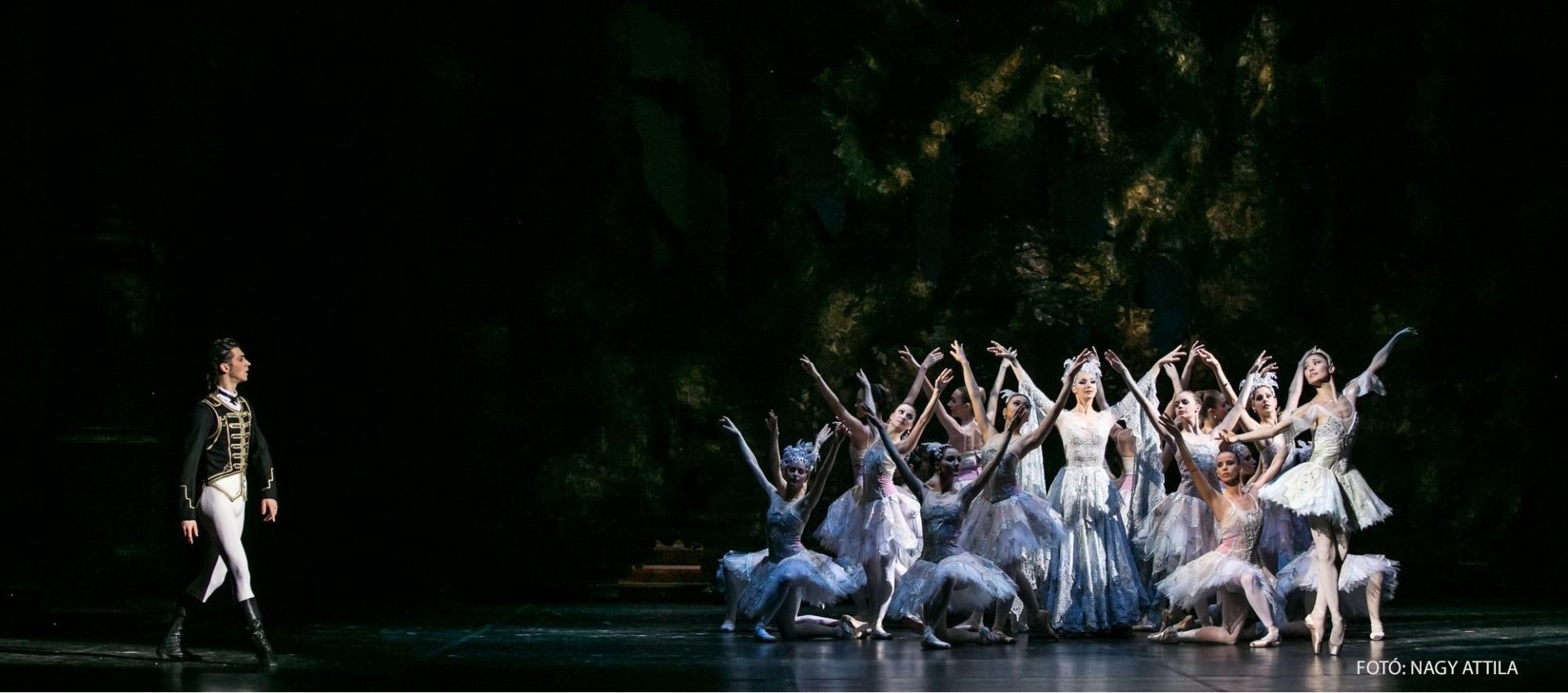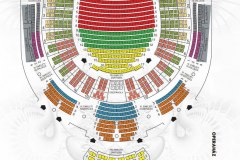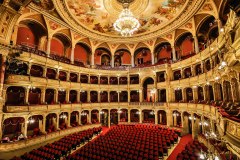The Sleeping Beauty
June 2026 | ||||||
|---|---|---|---|---|---|---|
Mo | Tu | We | Th | Fr | Sa | Su |
The Sleeping Beauty – Marius Petipa / Sir Peter Wright / Sir Frederick Ashton / Pyotr Ilyich Tchaikovsky
Ballet in Three Acts
Running time: 3 hours 15 minutes, including two intervals
A magical fairy tale on the ballet stage danced to the wonderful music of one of Russia's greatest composers. An outstand piece from the Romantic repertoire, The Sleeping Beauty fuses together all the grace and virtuosity found in the greatest ballets. The extraordinary technical demands of Marius Petipa's original choreography, considered one of the high points of classical ballet, offers dance companies an opportunity to display their talents. The ballet features Sir Peter Wright's reconception of Petipa's original ideas and stunning stage sets by Philip Prowse.
Age restriction: The performance is not recommended for children under 6 years of age.
Synopsis
Prologue
King Florestan and his wife have invited the Fairies from across their kingdom to the christening of their daughter Princess Aurora. As the fairies lavish fabulous gifts on the newborn, the outraged Carabosse bursts into the palace, furious that nobody has remembered to invite her to the festivities. She brings a spindle as a gift, but also places a curse on the princess: she will prick her finger on the spindle and die. Fortunately the Lilac Fairy still has her own gift to offer, which overrides the curse: Aurora will not die, but will instead fall into a deep sleep for a hundred years, and will be awakened by a Prince’s kiss.
Act 1
The Court is celebrating Aurora’s 17th birthday. Four Princes have come to seek her hand in marriage and vie with each other for her favours. They present her with roses.
Suddenly Aurora notices an old woman, who also gives her flowers in which a spindle is hidden. Everyone tries to take it away from her fearing she may harm herself, but she refuses to let go of it and in her excitement does indeed draw blood as she pricks herself. She suffers great pain and collapses as the King and the Princes rush to her aid.
The Queen remembers Carabosse’s terrible prediction at Aurora’s christening and fears the worst. The old woman now throws back her cloak, revealing herself as Carabosse. The Lilac Fairy then appears to fulfil her promise and, using her magical powers, sends the entire Court to sleep and causes a dense forest to rise, completely hiding the Castle.
Act 2
A hundred years later, Prince Florimund, from a neighbouring kingdom, is out hunting with members of his retinue in the forest protecting the Castle. He is joined by a countess whom he must marry but does not love. They pause from the chase for refreshment and then Gallison, Florimund’s equerry announces that a stag has been sighted and they all move off to continue the hunt.
Florimund himself, however, remains behind and ponders sadly on his loveless future. The Lilac Fairy now appears and shows him a vision of Aurora, with whom Florimund becomes enraptured, and he begs the fairy to take him to her. She leads him to the hidden Castle, where Aurora lies asleep. Carabosse attempts to prevent him from reaching her, but the Lilac Fairy banishes her from the kingdom forever. Florimund , instructed by the fairy, then awakens the Sleeping Beauty with a kiss. The spell has been broken, and they express their new found love for each other.
Act 3
The Wedding
Fairy-tale characters arrive to take part in the wedding celebration between Aurora and the prince, where everyone dances happily. The Lilac Fairy appears and blesses the union, and they express their true love. Good has triumphed over evil.
Program and cast
Conductor: David Coleman
Princess Aurora - Tatyjana Melnyik, Maria Yakovleva, Miyu Takamori, Maria Beck
Prince Florimund - Gergő Ármin Balázsi, Dmitry Timofeev, Viachaslau Hnedchyk, Boris Zhurilov
Lilac Fairy - Xénia Kulikova, Yuiko Adachi, Adema Omarova, Ágnes Kelemen
Carabosse - Aliya Tanykpayeva, Katerina Taraszova, Jessica Leon Carulla, Lea Földi
Enchanted Princess - Yuki Wakabayashi, Adrienn Pap, Claudia García Carriera, Erina Yoshie
The Bluebird - Motomi Kiyota, Vince Topolánszky, András Rónai, Mattheus Bäckström
Featuring the corps de ballet of the Hungarian National Ballet, the Hungarian State Opera Orchestra and the Hungarian National Ballet Institute.
Assistant choreographer: Denis Bonner, Miyako Yoshida
Costume supervisor: Michael Clifford
Set and costume designer: Philip Prowse
Technical adaptation: Doug Nicholson
Lighting designer: Peter Teigen
Hungarian State Opera
STANDING ROOM TICKETS - INFORMATION IN CASE OF A FULL HOUSE!
If all the seats are sold out for the selected time, but you still want to see the production on that day, 84 of the extremely affordable standing seats will be sold at the theatre, 2 hours before the start of the performance, with which you can visit the gallery on the 3rd floor. Tickets can be purchased at the ticket office of the Budapest Opera House. We would like to draw your attention to the fact that the stage can only be seen to a limited extent from the standing places and the side seats, but at the same time, following the performance is also supported by television broadcasting on the spot.
The Opera House is not only one of the most significant art relic of Budapest, but the symbol of the Hungarian operatic tradition of more than three hundred years as well. The long-awaited moment in Hungarian opera life arrived on September 27, 1884, when, in the presence of Franz Joseph I. the Opera House was opened amid great pomp and ceremony. The event, however, erupted into a small scandal - the curious crowd broke into the entrance hall and overran the security guards in order to catch a glimpse of the splendid Palace on Sugar út. Designed by Mikós Ybl, a major figure of 19th century Hungarian architecture, the construction lived up to the highest expectations. Ornamentation included paintings and sculptures by leading figures of Hungarian art of the time: Károly Lotz, Bertalan Székely, Mór Than and Alajos Stróbl. The great bronze chandelier from Mainz and the stage machinery moda by the Asphaleia company of Vienna were both considered as cutting-edge technology at that time.
Many important artists were guests here including Gustav Mahler, the composer who was director in Budapest from 1887 to 1891. He founded the international prestige of the institution, performing Wagner operas as well as Magcagni’ Cavalleria Rusticana. The Hungarian State Opera has always maintained high professional standards, inviting international stars like Renée Fleming, Cecilia Bartoli, Monserrat Caballé, Placido Domingo, Luciano Pavarotti, José Cura, Thomas Hampson and Juan Diego Flórez to perform on its stage. The Hungarian cast include outstanding and renowed artists like Éva Marton, Ilona Tokody, Andrea Rost, Dénes Gulyás, Attila Fekete and Gábor Bretz.

 EN
EN DE
DE IT
IT FR
FR ES
ES RU
RU JP
JP RO
RO
 Seating plan
Seating plan 